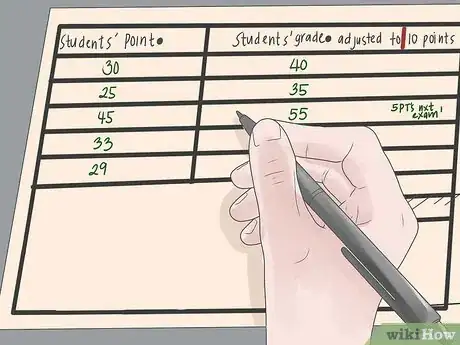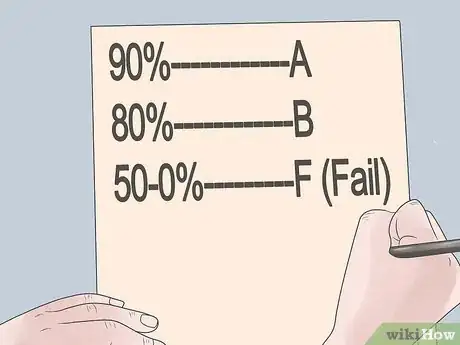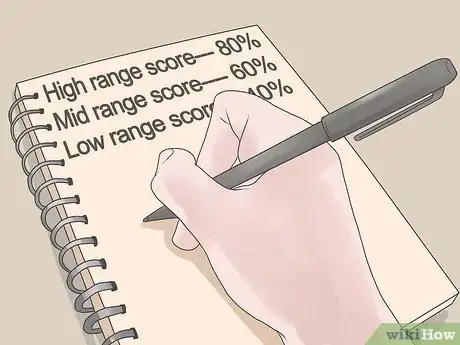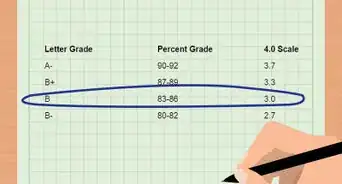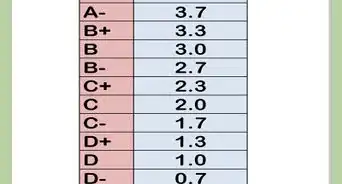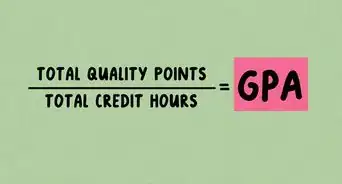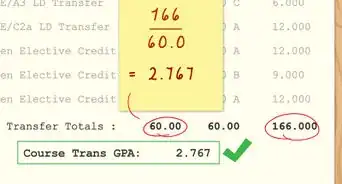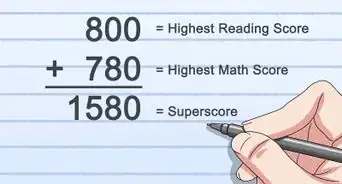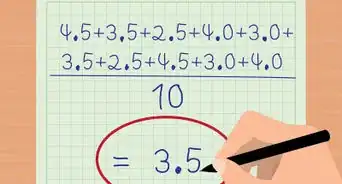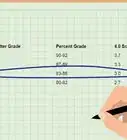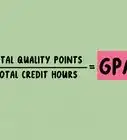wikiHow is a “wiki,” similar to Wikipedia, which means that many of our articles are co-written by multiple authors. To create this article, 18 people, some anonymous, worked to edit and improve it over time.
wikiHow marks an article as reader-approved once it receives enough positive feedback. This article has 12 testimonials from our readers, earning it our reader-approved status.
This article has been viewed 803,203 times.
Learn more...
A grade curve is a relative grading procedure that assigns grades for assignments based on the performance of the class as a whole. There are many reasons a teacher or professor may decide to curve a grade - for instance, if the majority of students performed below what was expected, which may imply that an assignment or test was out of range in either scope or difficulty. Some curving methods adjust grades mathematically, while others simply allow opportunities for students to recoup some of the points they lost on an assignment. Read on for detailed instructions.
Steps
Curving Grades Mathematically
-
1Set the highest grade as "100%". This is one of the most common (if not the most common) methods teachers and professors use for curving grades. This curving method requires the teacher to find the highest score in the class and set this as the "new" 100% for the assignment. This means that you subtract the highest score in the class from the hypothetical "perfect" score, then add the difference to every assignment, including the highest-scoring one. If done correctly, the highest-scoring assignment will now have a perfect score and every other assignment will have a higher score than it previously did.
- For example, let's say the highest grade on a test was 95%. In this case, because 100-95 = 5, we would add 5 percentage points to all of the student grades. This makes the 95% score an adjusted 100%, and every other score 5 percentage points higher than it was.
- This method also works using absolute scores, rather than percentages. If the highest grade was a 28/30, for instance, you would add 2 points to the score of every assignment.
-
2Implement a flat-scale curve. This technique is among the simplest of the methods used to curve grades. It is especially useful for when there was one especially difficult item on an assignment that a large majority of the class missed. To curve grades according to a flat-scale curve, simply add the same number of points to each student's grade. This can be the number of points that an item most of the class missed was worth, or it can be some other (arbitrary) number of points that you think is fair.[1]
- For instance, let's say that the entire class missed one problem which was worth 10 points. In this case, you might choose to add 10 points to every student's score. If you think the class doesn't deserve full credit for the missed problem, you might also choose to only give out 5 points.
- This method is closely related to the previous method, but it isn't exactly the same. Because this method doesn't specifically set the highest score in the class as a 100% maximum score, it allows for the possibility that none of the assignments receive a perfect score. It even allows for scores over 100%!
Advertisement -
3Set a bottom limit for F's. This curving method mitigates the effect that a few very low scores can have on a student's grade. Therefore, it's especially useful in situations where a student (or an entire class) bombed a certain assignment but have since shown serious improvement and, in your opinion, deserve not to fail. In this case, instead of the normal percentage designations for letter grades (90% for A, 80% for B, etc. down to 50-0% being an F), you define a lower limit for failing grades - a minimum score that is higher than zero. This makes it so that particularly low-scoring assignments have a less drastic effect when averaged with a student's good scores. In other words, a few bad scores are less likely to drag a student's overall grade down.[2]
- For example, let's say that a student completely bombs his first test, scoring a 0. However, since then, he's studied hard, receiving 70% and 80% on his next two tests. Un-curved, he has a 50% grade right now - a failing score. If we set a lower limit on failing scores of 40%, his new average is 63.3% - a D. It's not a great score, but it's probably fairer than failing a student who's shown real promise.
- You may choose to set separate lower limits for assignments that are turned in vs. assignments that are not. For example, you may decide that, for failing assignments, the lowest possible grade is 40%, unless it's not turned in at all, in which case 30% is the lowest possible score.
-
4Use a bell curve. Often, the range of grades on a given assignment are distributed in a way that resembles a bell curve - a few students get high scores, most of the students score mid-range scores, and a few students get low scores. What if, for instance, on a particularly difficult assignment, the few high scores are in the 80% range, the mid-range scores are in the 60% range, and the low scores are in the 40% range? Do the very best students in your class deserve low B's and the average students deserve low D's? Probably not. By using a bell curve grading method, you set the class's mean grade as a middle C, which means that your best students should get A's and your worst students should get F's, regardless of their absolute scores.[3]
- Begin by determining the class's mean (average) score. Add up all the scores in the class, then divide by the number of students to find the mean. Let's say that, after doing this, we find an average score of 66%.
- Set this as a mid-range grade. The precise grade you use is at your discretion - you may want to set the mean as a C, C+, or even B-, for instance. Let's say that we want to set our 66% as a nice, round C.
- Next, decide how many points separate the letter grades in your new bell curve. Generally, bigger point intervals mean that your bell curve is more forgiving to low-scoring students. Let's say that in our bell curve, we want to separate our grades by 12 points. This means that 66 + 12 = 78 becomes our new B, while 66 - 12 = 54 becomes our new D, etc.
- Assign grades according to the new bell curve system.
-
5Apply a linear scale grading curve. When you have a very specific idea of the grade distribution you want, but the actual grades in your class don't fit, you may want to use a linear scale curve. This curve allows you to adjust the distribution of grades so as to get the mean score exactly where you want it. However, it's also somewhat math-intensive and it technically uses a different grading curve for each student, which some may perceive to be unfair.[4]
- First, choose 2 raw scores (actual student scores) and determine what you want them to be after the curve. For instance, let's say the actual mean score on an assignment is 70% and you want it to be 75%, while the actual lowest score is 40% and you want it to be 50%.
- Next, create 2 x/y points: (x1, y1) and (x2, y2). Each x value will be one of the raw scores you chose, while each y value will be the corresponding score that you want the raw score to be. In our case, our points are (70, 75) and (40, 50).
- If you want a top score of 100% to stay as 100%, e.g. to avoid curving anyone's score above 100%, you may choose your second point as (100, 100), even if no one earned a perfect 100%.
- If you want a top score of 100% to stay as 100%, e.g. to avoid curving anyone's score above 100%, you may choose your second point as (100, 100), even if no one earned a perfect 100%.
- Plug your values into the following equation: f(x) = y1 + ((y2-y1)/(x2-x1)) (x-x1). Note the lone "x" without any subscripts - for this, plug in the score of each individual assignment. The final value you get for f(x) is the assignment's new grade. To clarify - you have to do the equation once for each student's score. You can evaluate everything but the lone "x" to simplify before substituting the "x" for each student.
- In our case, let's say we're curving an assignment that got an 80%. We would simplify the equation one time, as follows:
- f(x) = 75 + (((50 - 75)/(40-70))(x-70))
- f(x) = 75 + (((-25)/(-30))(x-70))
- f(x) = 75 + 0.83 (x-70)
- Then substitute x for each student and evaluate:
- f(x) = 75 + 0.83 (80-70)
- f(x) = 75 + 0.83 (10)
- f(x) = 75 + 8.3
- f(x) = 83.3 . The 80% "raw" score on this assignment is now curved to 83.3%.
- In our case, let's say we're curving an assignment that got an 80%. We would simplify the equation one time, as follows:
- First, choose 2 raw scores (actual student scores) and determine what you want them to be after the curve. For instance, let's say the actual mean score on an assignment is 70% and you want it to be 75%, while the actual lowest score is 40% and you want it to be 50%.
Giving Students Extra Help
-
1Offer re-do opportunities. If you're not interested in applying a complicated formula to your students' grades, but you still want to offer them a chance to improve their score on a certain assignment, consider offering students an opportunity to re-do sections of an assignment they did poorly on. Give the assignment back to students and allow them to re-do problems they missed. Then, grade the problems they re-did. Offer the students some percentage of the points they earned on their re-do attempt, and add these to their first score to get their final grades.
- Let's say that a student scored 60 points out of 100 on a test. We give the test back to the student, offering half-credit for any problems she re-does. She re-works the problems she missed, scoring 30 more points. We then give her 30/2 = 15 more points, making her final score 60 + 15 = 75 points.
- Don't allow students to merely correct the work they've done. Instead, to ensure they fully understand how to do the problems from start to finish, have them completely rewrite the items they missed.
- Let's say that a student scored 60 points out of 100 on a test. We give the test back to the student, offering half-credit for any problems she re-does. She re-works the problems she missed, scoring 30 more points. We then give her 30/2 = 15 more points, making her final score 60 + 15 = 75 points.
-
2Remove an item from the assignment and regrade. Even the best teachers occasionally put unfair or misleading questions on their tests. If, after grading, you find that there are one or two particular items that most of the students seemed to struggle on, you may want to disregard these questions and grade the assignment as if they weren't included. This is an especially good idea if a certain question used concepts that you haven't taught your students yet or if it falls outside the reasonable expectations for student performance. In these cases, re-grade assignments as if the problematic sections don't exist.
- Note, however, that this method gives extra weight to the questions you do choose to include. It may also anger students who did well on the questions you chose to eliminate - you may want to offer them some form of extra credit. Or, turn the tough question into a bonus question.
- If you are concerned about grades above 100% or grade inflation in general, you can set a policy that grades on any assignment are capped at 100%, 102%, etc.
-
3Assign extra credit problems. This is one of the oldest tricks in the book. After an assignment that went poorly for some (or all) of your students, offer your students a special problem, project or task that, if completed, will raise their scores. This may be an extra problem that requires creative thinking, an extra assignment, or even a presentation - be creative![5]
- However, use caution with this method - the students who probably need the most help are also the least likely to be able to answer super-hard extra credit questions. You may find that your extra credit assignments are more effective if they allow students to incorporate classroom concepts into outside-the-box projects and assignments. For instance, if you're teaching a class on poetry, you may want to offer an extra-credit assignment that requires students to analyze the rhyme scheme of their favorite pop song.
Our Most Loved Articles & Quizzes
Community Q&A
-
QuestionAfter watching the video, I'm not sure that is the best way to grade. While that rewards the top student, doesn't it also increase (reward) the grade of the lowest student?
 Community AnswerThe purpose of a curve is to benefit EVERYBODY. It does help the student with the lowest score, but it raises the average and makes you look better. But I see your point! You don't have to use a curve. As said in the article, it's best used sparingly, like when everyone scores badly on the same assignment, because if that happens, the problem might have been with you, not them.
Community AnswerThe purpose of a curve is to benefit EVERYBODY. It does help the student with the lowest score, but it raises the average and makes you look better. But I see your point! You don't have to use a curve. As said in the article, it's best used sparingly, like when everyone scores badly on the same assignment, because if that happens, the problem might have been with you, not them. -
QuestionWhat if the highest grade in my class is already 100 percent?
 Community AnswerIt depends. If, in a class of 40, there was only one student who made 100 percent, and everyone else was under 85 percent, it might me be a good idea to curve the grades. On the other hand, if 10 students out of 40 scored 92 and above, then there's likely no need to curve the grades.
Community AnswerIt depends. If, in a class of 40, there was only one student who made 100 percent, and everyone else was under 85 percent, it might me be a good idea to curve the grades. On the other hand, if 10 students out of 40 scored 92 and above, then there's likely no need to curve the grades. -
QuestionHow do I know if my curved grades are fair?
 Community AnswerYou don’t know because “fair” is subjective. If you feel the curved scores better reflect your situation, then it is “fair.”
Community AnswerYou don’t know because “fair” is subjective. If you feel the curved scores better reflect your situation, then it is “fair.”
References
- ↑ https://divisbyzero.com/2008/12/22/how-to-curve-an-exam-and-assign-grades/
- ↑ https://www.thoughtco.com/grading-on-a-curve-3212063
- ↑ https://blog.nus.edu.sg/provost/2012/01/20/the-bell-curve/
- ↑ https://library.uoregon.edu/sites/default/files/data/scis/blackboard/bb_linear_grade_curving.pdf
- ↑ https://help.d2l.msu.edu/msu-docs/d2l-grades-at-msu/d2l-gradebook-extra-credit
About This Article
To curve grades, start by finding the highest grade earned in the whole class. Then, subtract that grade from 100. Finally, add that number to every student's grade. For example, if the highest score in the class was 90 percent, you would subtract 90 from 100 and get 10. Then, you'd add 10 percentage points to every student's grade, including the student who scored the highest. To learn other ways you can curve grades, like using a flat-scale curve or a linear-scale curve, keep reading!

